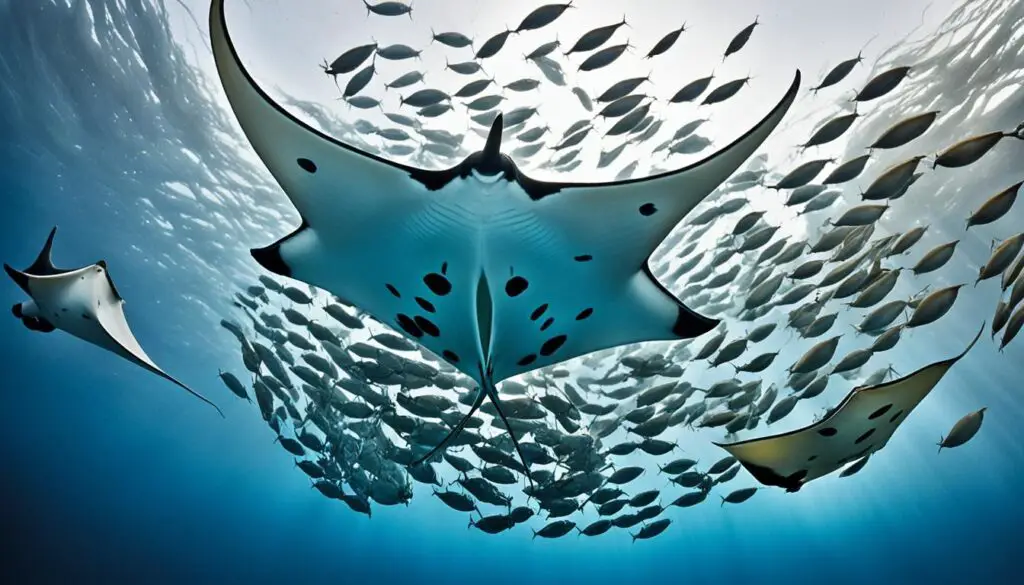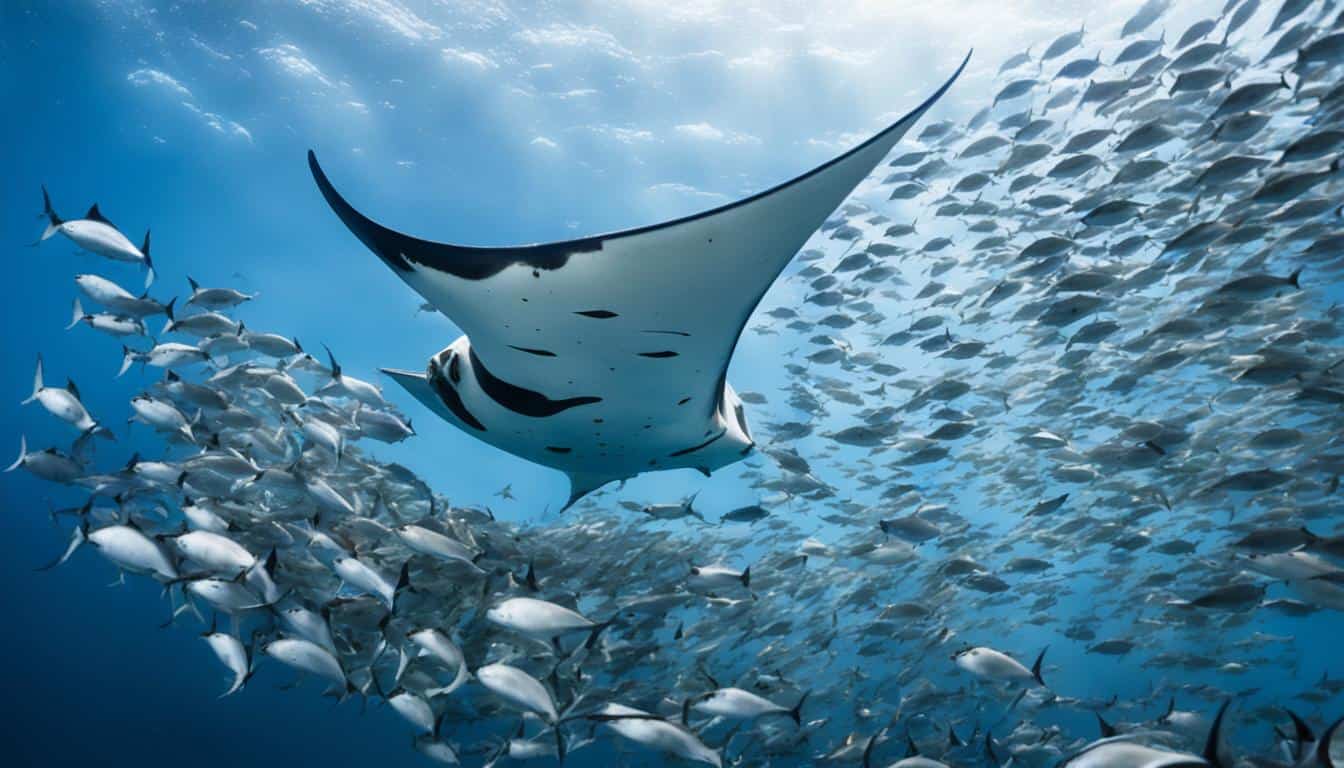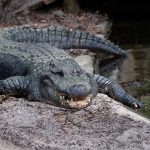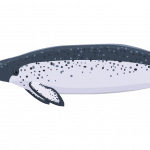Manta rays are fascinating creatures of the ocean, known for their beauty and size. They have a unique diet that mainly includes tiny organisms. You might ask, what do manta rays eat? Knowing about their diet helps us understand these amazing animals and their place in the ocean.
Their diet is mostly made up of zooplankton. This includes copepods, mysid shrimp, and fish larvae. These tiny creatures are crucial for the manta rays’ survival.
Manta rays eat a lot of food each week, up to 12% of their body weight. That means a huge number of plankton, about 19 million pieces for the bigger ones. Learning about their diet shows us how important they are to the ocean’s health.
Understanding the Manta Ray Diet
The diet of manta rays is quite interesting. It tells us about their eating habits and what they need to eat. There are two main types of manta rays: the giant oceanic manta ray and the reef manta ray. They are different in size, where they live, and what they eat, which is key to their survival.
Manta Ray Species and Their Dietary Needs
The giant and reef manta rays mainly eat zooplankton. Zooplankton is a tiny creature that floats in the water. These rays need zooplankton a lot for their diet. But, the giant manta ray sometimes eats small fish too. This helps it get the nutrients it needs when zooplankton is hard to find.
The Role of Plankton in Manta Ray Nutrition
There are over 5,000 types of plankton, and they are very important for manta rays. Eating plankton helps manta rays grow and have babies. Knowing what they eat is important for keeping their populations healthy and for protecting them.
| Manta Ray Species | Primary Diet | Additional Food Sources | Habitat |
|---|---|---|---|
| Giant Oceanic Manta Ray | Zooplankton | Small fish | Open ocean |
| Reef Manta Ray | Zooplankton | None documented | Coastal reefs |
What do manta rays eat?
Manta rays mainly eat plankton. This helps us understand their eating habits and their role in the ocean. They have special ways to eat these tiny organisms in the vast sea.
Types of Plankton Consumed by Manta Rays
Manta rays love to eat zooplankton, which includes tiny creatures floating in the ocean. These tiny organisms are crucial to the manta ray’s diet. Some key plankton types they eat are:
- Copepods
- Krill
- Small fish larvae
- Fish eggs
They catch these small creatures in nutrient-rich waters. Their special way of filtering water lets them eat a lot of these important foods.
How Manta Rays Capture Their Food
Manta rays have a unique way of eating that is quite interesting. They have special gill rakers that catch prey of manta rays while letting water go through. They also swim with their mouths open to catch more food. Their feeding strategy includes:
- Swimming slowly through areas full of plankton.
- Using gill rakers to separate food from water.
- Opening their mouths wide to catch more food.
As they swim, they gather their favorite foods efficiently. This shows how well they are adapted to life in the ocean.

| Type of Food | Size | Common Locations |
|---|---|---|
| Copepods | 0.5 – 2 mm | Surface waters |
| Krill | 10 – 30 mm | Mid to deep waters |
| Small fish larvae | 1 – 15 mm | Sandy and reef areas |
| Fish eggs | 1 – 3 mm | Nearshore areas |
Feeding Habits of Manta Rays
Manta rays have interesting ways of eating that change with the species. Their eating habits show how they survive in their homes. Reef and giant manta rays eat differently, showing their unique survival skills.
Feeding Techniques in Different Species
Reef and giant manta rays mostly eat by filtering food from the water. They swim with their mouths open to catch plankton. This method changes based on where they live. Both types filter feed, but they adjust to their food and water conditions.
Gathering in Large Numbers for Feeding
Manta rays often eat together in big groups, called “squadrons.” This teamwork helps them eat better and shows how they work together. Their coordinated eating shows how well they adapt and forage for food. This teamwork is key to their success in finding enough to eat.
Manta Ray Feeding Behavior in Various Environments
Manta rays have fascinating ways of finding food based on their surroundings. They adapt to different challenges in finding food. Coral reefs and open waters each offer unique chances and hurdles for these amazing creatures.
Feeding Near Coral Reefs vs. Open Waters
At coral reefs, manta rays find lots of plankton, making it a great place to eat. The reefs have nutrient-rich upwellings that help with this. They use their special feeding ways, like filtering water through their gills, to catch food efficiently here.
In open waters, finding enough food is harder for them. They use currents and look for food patterns to help with this. This shows how they adapt to different environments.
Effects of Light on Manta Ray Feeding
Light affects how manta rays eat in interesting ways. They go to artificial lights because they bring plankton. This shows how they use different resources based on what’s around them.
When lights are on, they come together to eat more. This shows how they can change their eating habits based on the environment. It’s a great example of how they adapt to get more food.
How Much do Manta Rays Eat?
It’s important to know how much manta rays eat to understand their role in the ocean. These huge creatures need a lot of food to stay healthy. They eat about 12-13% of their body weight each week.
For a 1,000-pound manta ray, that means eating around 120 pounds of plankton every week. That’s like eating 19,200,000 tiny pieces of plankton. This shows how much these creatures depend on plankton for food.
This huge amount of food helps keep the ocean’s balance. Manta rays eat so much plankton that they help control its population. Knowing this helps us understand the ocean’s complex life systems.
FAQ
What do manta rays primarily eat?
Manta rays mainly eat zooplankton. This includes things like copepods, mysid shrimp, crab larvae, mollusk larvae, and fish eggs.
How much food do manta rays need each week?
They need to eat about 12-13% of their body weight each week. This means they eat millions of plankton pieces, depending on their size.
What are the differences between giant oceanic manta rays and reef manta rays?
Giant oceanic manta rays are bigger and might eat small fish too. Reef manta rays mostly eat zooplankton. They live in different places and eat in different ways.
How do manta rays capture their food?
Manta rays use special structures called gill rakers to filter water. This helps them catch tiny food like plankton and small fish larvae.
What feeding techniques do manta rays exhibit?
They have amazing feeding ways. They swim with their mouths open to catch more food. Sometimes, they even feed together in big groups to eat in plankton-rich waters.
Where do manta rays typically feed?
Manta rays often feed near coral reefs, where there’s lots of nutrients. They also go into open waters to find food.
How does light affect manta ray feeding behavior?
Manta rays like artificial lights because they bring lots of plankton. This shows they can adjust their eating habits to find food.
Why is understanding the diet of manta rays important?
Knowing what manta rays eat helps us see their role in the ocean. They help with the food web and nutrient flow.







